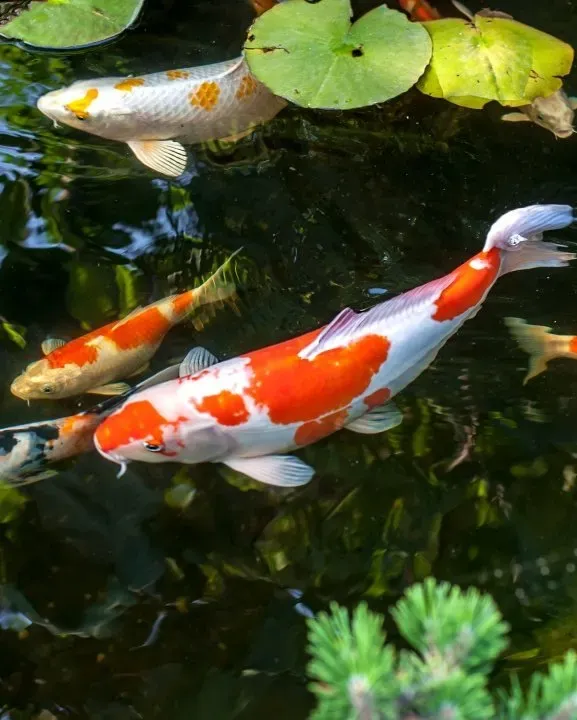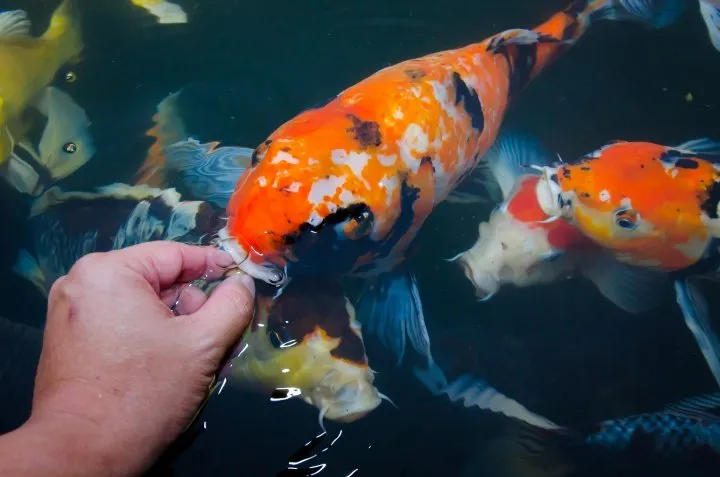The Beauty of Koi: Explore the Stunning Appearance of These Colorful Fish
One of the biggest reasons many people get a backyard pond is to keep fish. And even if the fish are an afterthought to your water garden, they quickly take center stage. The most popular type of pond fish is the beloved koi. Let’s explore the beauty of koi and what makes them so striking.
Koi are the crown jewels of the water garden. Because of their bright coloring and graceful movements, most people are surprised to learn that koi are descendants of the common, not-so-colorful carp. How the koi went from an average carp to an elegant fish with beautiful markings that sell for thousands of dollars is a story in itself.
Carp fossils dating back 20 million years have been found in China. The first koi was probably a carp with some unique color, which was then selected again and again by lineage for breeding by the Japanese. The Japanese lead the globe in the production of the finest colors of koi.
So, what makes a koi a quality koi? The value of quality fish is dependent on several factors. To the discerning eye, quality koi are based on the merits of color, pattern, conformation, and size. Although knowing the Japanese language is not necessary for koi keeping, variety names, colors, and descriptions often use Japanese terms.

The Power of Color and Pattern
Colors in the pattern of a high-quality koi should be strong and distinct. For example, red should be true red, not an orange-red color. White should be snow white, and black should be true black without a hint of gray. Not only are the clarity and depth of the koi’s coloration important in judging, it’s also important in a pond setting.
All colors of the fish should be of an even thickness over the body and unblemished by any other pigmentation (unless forming another pattern). Patterns should be well defined and not fade into the background color. No two koi are alike, and each variety has its own pattern parameters.
Markings should be well balanced throughout the fish’s body. Interestingly, it is important to the koi judge that the koi pattern be balanced from side to side and from front to back. Some judges will evaluate the fish in three sections — the head, the body, and the tail.
Though scales do not usually play a role in overall quality (unless they are missing), they can be an indication of koi type by the pattern they exhibit — full scalation, partial scalation (armor scale), or no scalation (doitsu or leather). Another interesting division among types of scales is the term kinginrin (abbreviated as ginrin), referring to a shine possessed by a koi’s scales. Ginrin scales are highly reflective, sparkling when they catch the light.
Matsuba describes a darker pattern in the center of the scales, resulting in what is often referred to as a pinecone pattern. Non-metallic matsubas are classed in kawari-mono, whereas metallic ones are classed in hikari-mono. Complete books have been written dissecting the meaning and nuance of the various terms used to judge koi.
The overall size of a koi will also command a greater value. Koi can exceed 40 inches in length, though most backyard ponds are too small or too crowded to allow the fish to grow to its maximum potential.
Conformation and Scales
Conformation describes the overall shape of the koi. Fish should have a strong-looking body with a sturdy thickness throughout. The body should be balanced and torpedo-shaped, with a symmetrical, straight backbone and an abdomen that is more rounded than the dorsal line (back).
The quality and appearance of the skin can also be a factor in good body conformation. Luster describes the shine that is present on the skin of a healthy koi. It also differentiates between metallic (hikari) and non-metallic (kawari). A shiny finish may make a koi look as if it has been lacquered with a clear varnish.
Skin quality like this is common in young koi, but not as much in older koi. Older fish tend to lose a lot of luster in coloration and overall skin quality. Colors fade, black age spots (shimi) may develop, and discoloration (yellowing replacing white) may occur.
For this reason, older koi that retain their luster and skin quality are highly sought after, commanding very high prices in the market. It also explains how a big, less attractive fish that produces impeccable babies, still could be priceless to a breeder.
Conformation is most important if you are planning to show your fish, but poor conformation such as apparent (or more obscure) deformities should still be avoided because they can be an indication of internal defects that may lead to future health problems. For most hobbyists who do not plan on showing their koi (few do), conformation could be considered the least important factor in choosing the right koi.

The Beauty of Koi as Pets
Anyone who owns koi will tell you that they have personality. Each koi is different not only in color, but also in the way they behave. Some shy away when you approach the side of the pond, while others quickly swim up to greet you.
Lucky is the person who has koi that eat directly from the hand. Treats like Koi Krunchies make it easier to train your fish to eat from your hand. Be patient as it may take days to weeks to get them acclimated to doing this.
Once they eat from your hand the first time, they’re likely to not shy away the next time. You also might be surprised to find your koi will rub up against your legs when you wander into the pond, much like your cat does.
Regardless of the beauty of koi in their color and patterns, they make valuable pets for the great enjoyment they bring to you and your family. Each one is unique and can be enjoyed for years to come.
